How do the stars move across the sky?
We are used to saying that the Sun/Moon/planets/stars "move across
the sky". That's because we interpret everything relative to
us. We live on a rotating system, so really the stars
are not moving - we are!
|
Let's orient ourselves - pretend you are looking down on the
Solar System from above so that the Earth goes counter-clockwise
around the Sun. From that viewpoint, the Earth would also rotate
counter-clockwise on its own axis. So, since the East rotates toward
the Sun first, we see the Sun "rise" in the East. Later, the
West will rotate around so the Sun "sets" in the West. |
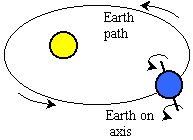 |
The stars also "rise" and "set" just like the Sun
and the moon. How can we detect the movement of the stars? Use a simple 35
mm camera and a sturdy tripod. Just point the camera at the sky, use the
BULB setting, and let it sit there for as long as you want (at least 10
minutes to get some trailing of the stars). If you are not in a very "dark"
location, the "sky glow" will creep onto the film, and you won't
be able to leave the camera open as long - if you are in a dark site - go
for an hour or more!
What will you see in the images? Well, it depends on where you point the
camera. The stars appear to move because we in fact are rotating around
the Earth's axis. Luckily, there is a star up in the sky very near the
point where the Earth's North Pole points .. the North Star (Polaris).
Thus, as the sky rotates above us (meaning, we turn against the background
of the stars), the North Star should not move very much. (It moves just
slightly because the axis is not quite pointing at the star - but
basically the North Star is always in the same point in the sky for us).
What about the stars near the North Star .. they will rotate around the
North Star. If you face the North Star, the stars will appear to rotate
counter-clockwise around that point.
As you get farther from the North Star, the stars still rotate, but
their trails appear to straighten out (and the tracks seem longer). These
two effects are connected - the star farther away in the sky makes a
larger circle with respect to the North Star .. so a segment of its path
should appear straighter than near the North Star. Also, since the distant
star has to go all the way around its bigger circle in 24 hours - it has
to cover more "distance" along that path in a 10 minute period
than a star that is making a small circle around the North Star.
 |
| [Here is a composite of a sky strip from the North
horizon to the South Horizon.] |
The strip above shows 7 images that were blended together to form a "sky
strip". On the left is the North Horizon - then the camera is tilted
up slightly, and another shot is taken .. then tilted again .. another
shot .. etc. Finally, the camera is pointing at the Southern Horizon.
There is more detail in the strips below, but let me give you some
pointers to watch for :
- Stars near Northern Horizon contain the "cup" of the Big
Dipper.
- Those stars curve reasonably strongly.
- Near the North Star, the stars curve alot - but the trails are short.
- As we get to the middle (which would be straight up), the stars curve
less.
- Near the "Equator" (imagine the Earth's
equator projected out into space), the stars move straight.
- Notice that the farther you get from the North Star, the trails are
longer.
- On other side of equator, stars trails bend the other way!!
[If we could see where the Earth's South pole points in the sky .. the
stars would curve strongly around that, same as with the North Pole. There
is no "star" where the South pole points, but there is a "clear
space" in the sky in the general vicinity (not many stars, by
coincidence).]
Here are two images (one in color and one in greyscale) presented
vertically so you can scroll up and down a little better. The greenish
tint is a result of the low light and the sky "glow" (lights
from the nearby towns), and is an artifact of the film (the sky was not
green!). The next time I get to a really dark site, I will update this
with better photographs (and hopefully a longer exposure time).
Color sky strip
Composite Color images - 10 minute exposures using Fujicolor800 film
- 50mm lens f/stop=1.8
 |
Black and White sky strip
Same images were scanned, but only greyscale .. then inverted (black
to white) to bring out the faint detail.
 |
|
Closer look at the Southern Horizon?
With a sideways picture, and a slightly darker sky, we could more
clearly see the "downward" curve of the southern stars. (I'm
still waiting to get a nice dark sky and a long time exposure!)
[Click on the image to see the larger picture.] |
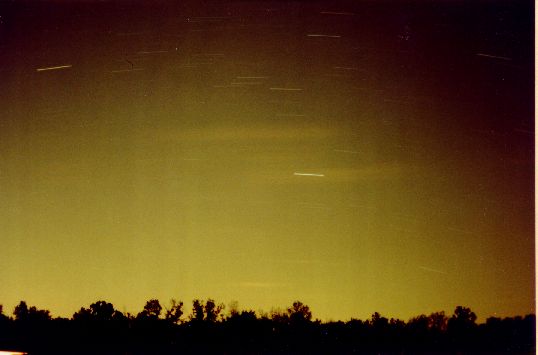 |
What can you do?
If you have a 35 mm camera and some color film - I highly recommend you
taking some "star trails" pictures. You want to find a dark sky
and it is better to shoot up toward the sky overhead (since there would be
less of the horizon glow that way). I'm still playing around with what
speed films work the best : slow films have good resolution, but might not
pick up some of the fainter stars, higher speed films pick up the fainter
light, but don't have as fine a resolution. I've used 400 and 800 speed
film with good results - I'm going to try some 100 speed and see what I
get.
Why color film and not black and white film?
When we look up in the night sky, we basically just see "white"
stars. Sometimes we get the feeling that a star is a different color
than white (more reddish or blueish). The problem is that our eyes
don't perceive color very well in low light situations (dark night
sky!). But, film can! The light accumulates on the film, and the
colors can be resolved. I tried to search my film archives .. but I
obviously have to do some better organizing .. here is a part of an
image that will show slightly different colors. (I'll try to get a
better example here!) |
 |
What is that "equator" that you talked about and also what is
the "ecliptic"?
Most of the orbits of the planets around the sun fall along the same
plane (large flat surface). A few are tilted a little bit from the plane,
and Pluto is tilted alot! The Earth's Moon also moves basically along that
same plane. Thus, when the Sun moves across the sky, or the Moon, or the
planets - they all bascially follow the same path in the sky (with slight
variations). We call this path the ecliptic.
If you imagine the Earth's equator extended outward into space .. there
will be a "line" across the sky - we call that the equator.
So, we have one giant circle in the sky which is the ecliptic (where the
sun/moon/planets) travel, and another giant circle representing the
Earth's equator projected up into the sky. Do they cross? Yes, at two
times of the year : the Vernal (Spring) Equinox, near March 21st, and the
Autumnal (Fall) Equinox, near September 21st (you'll see than in an
illustration later on the page).
|
Which one is responsible for the star trail curves? The
stars appear to move because of the Earth's rotation, right .. thus,
it must be the equator that defines how the stars curve - "above"
the equator the stars apear to curve around the North Pole (or the
North Star) - "below" the equator, the stars appear to curve
around the South Pole (or that big "gap" in the stars). |
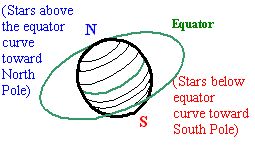 |
Can we see an example of the planets being in different orbits?
Well, this is tricky. The ecliptic is tilted relative to the equator
(since the Earth's axis is tilted relative to the plane of the Solar
System). So, two planets might have orbits that would put them in a path
very near each other lined up with the ecliptic, but because of the
rotation, they will appear to be separated in the sky if we let the
planets "trail" on the film.
|
Planet-trail photo! For example, if we take a time exposure
of Saturn and Jupiter - we would see that there is an apparent
separation in the sky of their trails. Here is a 10 minute exposure of
two planets : Saturn (on the left) and Jupiter (on the right). [Notice
the Pleiades - a cluster of stars - on the far left - they form a
tight group of trails!]
It seems like we need to know more about the Equator and the
Ecliptic to understand what is really happening in this photo! Keep
reading! |
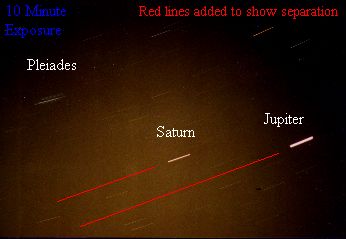 |
|
How is the ecliptic oriented relative to the equator? In
this illustration we pretend the solar system is horizontal (the usual
way we think of it). Since the Earth axis is tilted about 23 degrees
away from the Solar system plane, the Earth's Equator will tilt up by
that same 23 degrees as illustrated.
There are two places where the curves cross - each are the "Equinoxes"
- in the Spring is the Vernal Equinox - in the Fall is the Autumnal
Equinox.
(In fact, if we want to talk about where planets are relative to
each other, we need a way to measure the angles from the Sun. The "reference
direction" chosen is the line that connects the Earth and the Sun
at the moment of the Spring Equinox {where the two curves to the left
intesect}. Continue that line through the Sun and out the other side,
and it becomes the line in space that we start the angles from. |
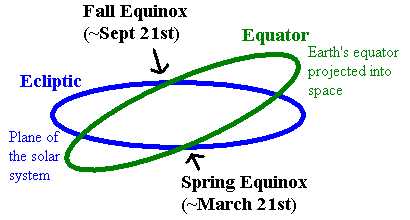 |
|
Where are Jupiter and Saturn currently? Here is a plot that
shows the positions of Jupiter and Saturn around their orbits
(roughly) and shows where the Earth is in its orbit. [Note, this also
explains why we see Jupiter to the "West" of Saturn in the
sky - Saturn is farther along the orbit than Jupiter - in fact, in a
few years, since Jupiter is closer than Saturn, and moves faster in
the orbit - Jupiter will "line up" with Saturn, and then
pass Saturn, and be "East" of Saturn for a few years, and
then it will "catch up" to Saturn again from the "West".
{Jupiter has an orbit period of about 12 years, Saturn has an orbit
period of about 30 years.}]
Also, notice the lines drawn from "the sun" to the planets
- the line for the Earth is almost pointing completely to the right.
Near the end of September, the Earth will be directly to the right of
the Sun in this diagram (6 months later, it will be directly to the
left - the Spring Equinox!).
This illustration was made with
HomePlanet - see info
in "references" section below. |
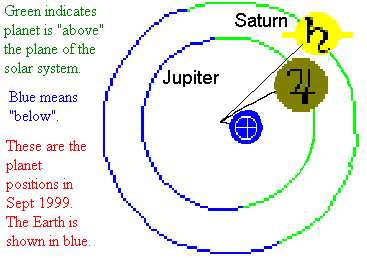 |
|
Let's connect that back to the photo of Jupiter and Saturn!
Look back at the planet-trail photo. Notice the red lines (they were
added afterwards .. the planets don't leave colored streaks like that
- ha!) - they seem to indicate that Saturn and Jupiter are not
trailing along the same line. But, this is misleading!!! Saturn and
Jupiter are slightly above the ecliptic (we know that from the
previous picture) - but, because of the angle between the ecliptic and
the equator, it makes the trails for the planets appear to be
separated! So any of the planets we try to "trail-photograph"
will trail at an angle relative to their actual path through the Solar
system. |
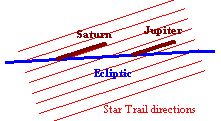 |
Curving planet trails? If you have sharp eyes, you will notice
in the planet-trail photo above, the stars near the planets (and the
planets themselves) appear to be bending "upward" a little (the
North Star is in the direction of the upper left corner of that picture.
That is another indication that the curves relate to the equator
... the ecliptic is "above" the equator (closer to the North
Star) in that part of the sky .. so all the trails of the planets in that
part of the sky will curve upwards!
|
Is there a constellation that "straddles" the equator?
Yes, the winter constellation Orion (the one with the three stars in
the belt) overlaps the equator. If you took a long-time exposure
picture of Orion, you might be able to see the stars in the upper part
curve upwards, and the stars in the lower part curve downwards - I'll
try that this winter and post the results here! (Here is a figure from
HomePlanet for Orion {I added the stars so we could see it better}.
The belt for Orion is just below the equator - with very long time
exposures, it might be possible to see the top part of Orion trying to
curve to the North, and the bottom trying to curve to the South! |
 |
|
Star Trails in Orion?
Since the constellation straddles the equator, the stars within it
will basically travel in straight lines with our star trail pictures.
(If we have a long enough exposure, we might see the stars to the "north"
trail with slight upward curves, and the stars to the "south"
trail with slightly downward trails.
Here is a picture taken very early in the morning in September
(Orion is high in the sky in the winter .. but starts rising in the
fall way past midnight). I need a darker sky, to be able to get the
contrast better - but you can see the nearly straight lines.
[Click on the image to see a larger version.] |
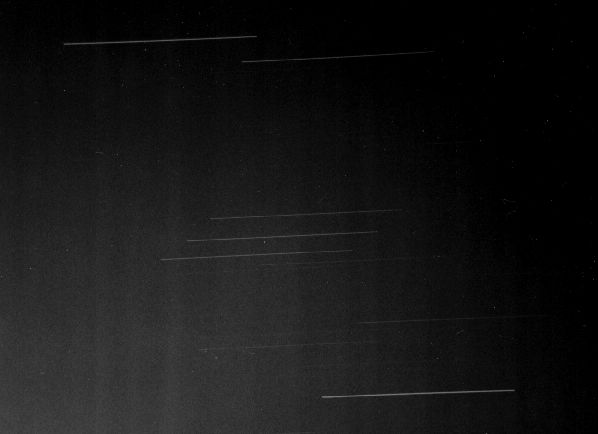 |
References :
All of the photographs are my own. Some of the illustrations here were
created by me personally. The HomePlanet illustrations were created using
a fabulous Astronomy Software program called
HomePlanet. (The link
contains information on HomePlanet 2 which would run on Windows 3.1 and
Home Planet 3 which is for 32 bit Windows {9x or NT}. I highly recommend
this program!!)
Watch this space for more detailed pictures in the
future!
Do you have any questions - or did I make a mistake?
Email me!
Return to Main Astronomy Page












